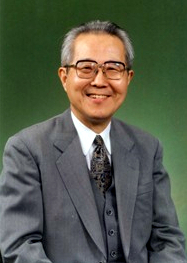Takashi Negishi
Takashi Negishi ( Japanese 根 岸 隆 , Negishi Takashi ; born April 2, 1933 in Tokyo Prefecture ) is a Japanese economist .
Career, research and teaching
Negishi studied economics at Tokyo University . After graduating, he stayed at the college, where he was later appointed professor. He later taught at Aoyama Gakuin University .
Negishi already dealt with the general equilibrium theory, which reappeared in the 1940s and 1950s , and published some papers in which he tried to expand and explore the theory with mathematical methods. Characterized by the work of John Richard Hicks, the aim was to model as many elements of the economic process as possible, such as growth, money, uncertainty and stability. In doing so, he discovered some limits of the previous theory. After Kenneth Arrow , Leonid Hurwicz and Lionel McKenzie in particular had postulated stable equilibria as central and Herbert Scarf and David Gale had presented significant counterexamples for the approaches of the three mentioned, Negishi developed another approach for stable equilibria together with Frank Hahn .
After Negishi had primarily dealt with the application of general equilibrium theory to the basic microeconomic building blocks of Keynesian macroeconomics in the 1970s , he turned to the history of economic theory from the middle of the following decade and presented theoretical comparisons between various approaches.
In 1994, Negishi served as president of the Econometric Society . In 2006 he was honored as a person with special cultural merits , in 2014 he was awarded the Order of Culture .
Web links
- Takashi Negishi at newschool.edu
- Literature by and about Takashi Negishi in the catalog of the German National Library
| personal data | |
|---|---|
| SURNAME | Negishi, Takashi |
| ALTERNATIVE NAMES | 根 岸 隆 (Japanese) |
| BRIEF DESCRIPTION | Japanese economist |
| DATE OF BIRTH | April 2, 1933 |
| PLACE OF BIRTH | Tokyo prefecture |
